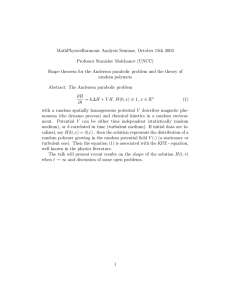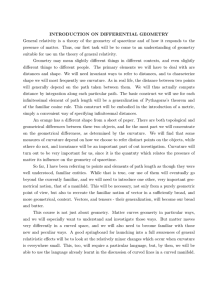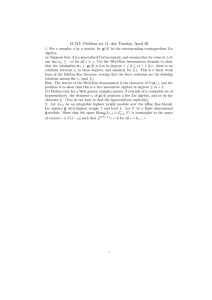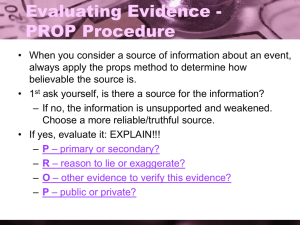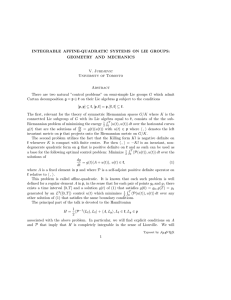AN ANALOG OF THE FEFFERMAN CONSTRUCTION
advertisement
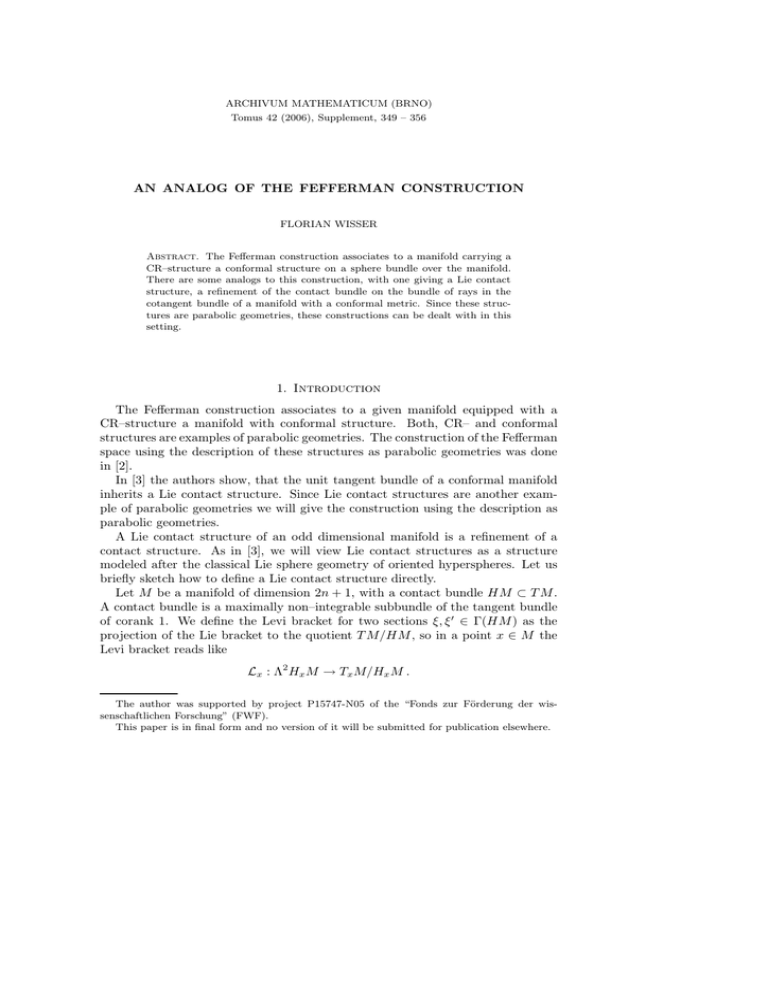
ARCHIVUM MATHEMATICUM (BRNO)
Tomus 42 (2006), Supplement, 349 – 356
AN ANALOG OF THE FEFFERMAN CONSTRUCTION
FLORIAN WISSER
Abstract. The Fefferman construction associates to a manifold carrying a
CR–structure a conformal structure on a sphere bundle over the manifold.
There are some analogs to this construction, with one giving a Lie contact
structure, a refinement of the contact bundle on the bundle of rays in the
cotangent bundle of a manifold with a conformal metric. Since these structures are parabolic geometries, these constructions can be dealt with in this
setting.
1. Introduction
The Fefferman construction associates to a given manifold equipped with a
CR–structure a manifold with conformal structure. Both, CR– and conformal
structures are examples of parabolic geometries. The construction of the Fefferman
space using the description of these structures as parabolic geometries was done
in [2].
In [3] the authors show, that the unit tangent bundle of a conformal manifold
inherits a Lie contact structure. Since Lie contact structures are another example of parabolic geometries we will give the construction using the description as
parabolic geometries.
A Lie contact structure of an odd dimensional manifold is a refinement of a
contact structure. As in [3], we will view Lie contact structures as a structure
modeled after the classical Lie sphere geometry of oriented hyperspheres. Let us
briefly sketch how to define a Lie contact structure directly.
Let M be a manifold of dimension 2n + 1, with a contact bundle HM ⊂ T M .
A contact bundle is a maximally non–integrable subbundle of the tangent bundle
of corank 1. We define the Levi bracket for two sections ξ, ξ ′ ∈ Γ(HM ) as the
projection of the Lie bracket to the quotient T M/HM , so in a point x ∈ M the
Levi bracket reads like
Lx : Λ2 Hx M → Tx M/Hx M .
The author was supported by project P15747-N05 of the “Fonds zur Förderung der wissenschaftlichen Forschung” (FWF).
This paper is in final form and no version of it will be submitted for publication elsewhere.
350
F. WISSER
Suppose that this subbundle decomposes into HM = L∗ M ⊗RM , where rank(L∗ M )
= 2 and rank(RM ) = n and RM is equipped with a metric of signature (p, q).
A manifold
M, HM = L∗ M ⊗ RM ⊂ T M, (RM, g)
carries a Lie contact structure of signature (p, q) if the Levi bracket is O(RM )–
invariant, i.e. for all ξx , ξx′ ∈ L(Lx M, Rx M ) and any A ∈ O(Rx M ) we have
Lx (ξx , ξx′ ) = Lx (A ◦ ξx , A ◦ ξx′ ) .
In the case considered here, we will use the canonical contact structure on the
bundle of rays in the cotangent bundle. Starting with an arbitrary manifold M of
dim(M ) = n + 1 we define
P r T ∗ Mx := {[ϕ]|ϕ ∈ T ∗ M, ϕ ∼ ψ ⇐⇒ ϕ = λψ,
λ ∈ R+ }
for x ∈ M and P r T ∗ M = ⊔x∈M P r Tx∗ M , so dim(P r T ∗ M ) = 2n+1. The bundle of
rays is a 2–fold cover of the projectivised cotangent bundle and hence carries a natural contact structure which is closely related to the natural symplectic structure
of the cotangent bundle. The contact subbundle is given by
Hϕ P r T ∗ M := {ξ ∈ Tϕ P r T ∗ M |ϕ(Tϕ p · ξ) = 0}
where ϕ denotes a class in P r T ∗ M .
We will stick to the viewpoint of parabolic geometries in the sequel and do the
construction in this picture. So a Lie contact structure will be a regular normal
parabolic geometry of type (G̃, P̃ ) and a conformal structure will be a normal
parabolic geometries of type (G, P ) for the groups defined below.
2. The homogeneous model
2.1. The homogeneous model of Lie contact structures. Let
Ṽ = (Rn+4 , h, ip+2,q+2 )
be a real vector space with an inner product of signature (p + 2, q + 2), where
n = p + q. We will call a vector v in Ṽ positive, null or negative if hv, vi is positive,
zero or negative respectively. When referring to an explicit basis we will use the
standard base {e1 , . . . , en+4 } with the inner product given by
hv, wip+2,q+2 := v1 wn+4 + w1 vn+4 + v2 wn+3 + w2 vn+3 +
p+2
X
vi wi −
n+2
X
i=p+3
i=3
So the matrix associated to this inner product reads like
0
J := 0
J′
0
Ip,q
0
J′
0
0
where
Ip,q :=
Ip
0
0
,
−Iq
J′ :=
0
1
1
.
0
vi wi .
AN ANALOG OF THE FEFFERMAN CONSTRUCTION
351
Define G̃ = P SO(p + 2, q + 2), which is just SO(p + 2, q + 2) in case that n is
odd, whereas for n even SO(p + 2, q + 2) is a 2–fold cover of P SO(p + 2, q + 2).
Take a look at the Lie algebra of G̃, which is g̃ = so(Ṽ ) and realize g̃ as
a
b
R
e
0
c
d
S
0
−e
t
t
V W
Z
−JS
−JR
f
0 −W t J −d
−b
0 −f −V t J
−c
−a
a b
with respect to the standard basis, where
∈ gl(2, R), Z ∈ o(p, q), V, W ∈
c d
Rn , R, S ∈ Rn ∗ and e, f ∈ R.
We look at the space N of null–planes in Ṽ . The choice of a fixed null–plane
N0 gives a filtration on Ṽ , explicitly Ṽ l = Ṽ for all l ≤ −1, Ṽ 0 = N0⊥ , Ṽ 1 = N0
and Ṽ l = {0} for all l ≥ 2. By P̃ we denote the stabilizer of this null–plane in G̃.
Choosing the fixed null–plane to be N0 = span{e1 , e2 } the filtration on g̃ induced by the filtration of the representation space is easy to see. We get a filtration
of g̃,
withthe associated |2|–grading, where g̃−2 corresponds to f , g̃−1 to V, W , g̃0
a b
to
, Z, g̃1 to X, Y and g̃2 corresponds to e. So g̃ = g̃−2 ⊕ g̃−1 ⊕ g̃0 ⊕ g̃1 ⊕ g̃2
c d
with the parabolic subalgebra p̃ = g̃0 ⊕ g̃1 ⊕ g̃2 containing all block upper diagonal
matrices, with V, W and f zero.
Note that g̃−2 ⊕ g̃−1 is Heisenberg, i.e.: the Lie bracket [ , ] : g̃−1 × g̃−1 → g̃−2
is non–degenerate. Furthermore g̃−1 may be identified with L(R2 , Rn ), where Rn
carries an inner product of signature (p, q) and the Lie bracket [ , ] is invariant
under the action of O(p, q) on Rn . Using this one concludes that a regular parabolic geometry of type (G̃/P̃ ) has an underlying structure as described in the
introduction, see [2] for further discussion.
To see that P̃ is the parabolic subgroup characterized by the fact that the
adjoint action of the group preserves the filtration of the respective Lie algebra,
i.e.
P̃ = {g ∈ G̃| Ad(g)(g̃i ) ⊂ g̃i } for all i ,
we can write a generator of g̃2 as a map, which takes v ∈ Ṽ to hv, e2 ie1 − hv, e1 ie2 .
Applying the adjoint action Ad(g) we get v 7→ hg(v), e2 ig(e1 ) − hg(v), e1 ig(e2 ) and
for this to be in g̃2 we need g(e1 ), g(e2 ) ∈ N0 . This is equivalent to g(N0 ) ⊂ N0
and hence P̃ is exactly the stabilizer of N0 in G̃.
We want to identify the homogeneous space G̃/P̃ with the space of null–planes
in Ṽ . To see that G̃ acts transitively on N we take an arbitrary null–plane
M = span{m1 , m2 } ∈ N
and N0 = span{e1 , e2 } ∈ N .
By non–degeneracy of h , i we find mn+4 ∈ Ṽ with hmn+4 , mn+4 i = 0 and
hm1 , mn+4 i = 1. We find a similar element for m2 which we denote by mn+3 and
again by non–degeneracy it is clear, that span{m1 , m2 }∩span{mn+3 , mn+4 } is trivial. Choosing an orthonormal basis of the complement of span{m1 , m2 , mn+3 , mn+4 }
and denoting it {m3 , . . . , mn+2 } the map A mapping ei 7→ mi for all i ∈ {1, . . . , n+
352
F. WISSER
4} lies in O(p + 2, q + 2). To find an element A ∈ SO(p + 2, q + 2) we may choose
to map e3 7→ −m3 and since the class [A] ∈ P SO(p + 2, q + 2) is either {A} or
{A, −A} all members of this class map A(N0 ) = M . Now G̃ acts transitively on
N with P̃ being the stabilizer of N0 ∈ N and we identify the homogeneous space
G̃/P̃ ∼
= N.
The homogeneous space (p : G̃ → G̃/P̃ , ω MC ) as a P̃ -principle bundle with
MC
ω̃
the Maurer–Cartan form on G̃ is the homogeneous model of Lie contact
structures of signature (p, q). Since Cartan connections are a generalization of
the Maurer–Cartan form, ω̃ MC is a Cartan connection and since the curvature of
a Cartan connection is an obstruction against the Maurer–Cartan equation, it is
flat.
2.2. The construction in the homogeneous model. We fix the vector ṽ0 =
e2 −en+3
√
with the property hṽ0 , ṽ0 i = −1 and denote the orthogonal complement
2
V = ṽ0⊥ and the orthogonal projection σ : Ṽ → V . Having chosen the subspace V
there are two kinds of null–planes in Ṽ , the ones lying in V and transversal ones.
We denote the set of transversal null–planes by Nt . In case of q = 0 all null–planes
are transversal, if q > 0 then Nt ⊂ N is an open subset.
The construction starts off with the homogeneous model of conformal structures. The inner product on Ṽ restricts to an inner product of signature (p+2, q+1)
on V . Take G = SO(p + 2, q + 1) acting on V ⊂ Ṽ with respect to this inner product. Let C := {v ∈ V |hv, vi = 0, v 6= 0} be the null–cone in V with PC the quadric
– its projectivization. Define P to be stabilizer of the null–line l0 := N0 ∩ V in
G. l0 is just the line through e1 with our choices of N0 and ṽ0 . G acts transitively on C, which can be seen by a similar argument as above, so we identify
G/P ∼
= PC ∼
= S n+1 . The tangent space T[v] S n , which is just v ⊥ /Rv inherits
an inner product of signature (p + 1, q) from V , which depends on the choice
of v ∈ [v]. This gives a conformal class, so S n is the conformal sphere. The
tangent space in the identity TeP G/P = l0⊥ /l0 = g/p. The homogeneous space
(p : G → G/P, ω MC ) with ω MC the Maurer–Cartan form is the homogeneous
model of conformal structures.
We embed G ֒→ SO(p + 2, q + 2) as the subset fixing ṽ
0 . In a
basis of the
1 0
form {ṽ0 , . . . } an element A ∈ SO(p + 2, q + 2) has the form
. Projecting
0 A
the image of G to P SO(p + 2, q + 2) is still injective, since A and −A are in
different classes. The inclusion on the level of Lie algebras is easy to see, since
g = so(p + 2, q + 1) ⊂ g̃ is just the subset annihilating ṽ0 :
a
e
R
e
0
f
0
S
0
−e
t
V W
Z
−JS −JRt
.
f
0 −W t J
0
−e
0 −f −V t J
−f
−a
This Lie algebra admits a |1|–grading where g−1 corresponds to V and f , g0 to a,
S, W and Z, and g1 corresponds to R and e. p = g0 ⊕ g1 the set up block upper
AN ANALOG OF THE FEFFERMAN CONSTRUCTION
353
matrices with respect to this grading is a parabolic subalgebra. The parabolic
subgroup P is characterized by the fact, that the adjoint action on g preserves the
respective filtration.
Now we define Q := P̃ ∩ G where G is in fact the embedding of G in G̃. P̃
stabilizes N0 and G stabilizes V , so Q stabilizes l0 = N0 ∩ V and hence Q ⊂ P .
We now consider the action of G on the space of transversal planes Nt , which is
an open subset of G̃/P̃ . Take an arbitrary null–plane N ∈ Nt . We can choose a
basis {n1 , n2 }, such that n1 ∈ V and n2 = σ(n2 ) + ṽ0 with hσ(n2 ), σ(n2 )i = 1 and
hn1 , σ(n2 )i = 0. We find an element of G mapping n1 to e1 and σ(n2 ) to σ(e2 )
and hence mapping N to N0 . So G acts transitively on Nt .
The projection E0 := σ(N0 ) is a plane in V containing the null–line l0 , with
all other directions positive. In the basis of N0 from above we get σ(e1 ) = e1 ∈
V , so l0 = Re1 and hσ(e2 ), σ(e2 )i = 1. By construction Q stabilizes E0 ⊂ V ,
σ|N0 : N0 → E0 defines a linear isomorphism and γ(e) := hσ −1 (e), ṽ0 i is a linear
functional on E0 , which gives an orientation on E0 preserved by the action of Q.
But this is equivalent to preserving the class of σ(e2 ) in l0⊥ /l0 with its orientation.
So Q is the orientation preserving stabilizer of the positive line E0 /l0 in l0⊥ /l0 .
Now g/p carries a conformal class of inner products of signature (p + 1, q) with
an oriented positive line E0 /l0 which is preserved by Q, and this characterizes Q.
Using the conformal class on g/p an oriented line in g/p gives an oriented line
in p+ = (g/p)∗ as the annihilator of the orthogonal complement. Since via this
identification we get a conformal class on p+ we have seen, that Q is the stabilizer
of a positive line in p+ .
The action of P on p+ has 3 orbits in case of non–trivial signature corresponding
to negative, null and positive directions, whereas in definite signature there is only
one orbit of positive directions. Since Q is the stabilizer of a positive line in
p+ preserving its orientation, we identify P/Q with the set of rays of positive
r
(p+ ) in p+ .
directions P+
With Q ⊂ P we get a natural projection G/Q → G/P . Since G/Q is identified
with the set Nt , which is an open subset of N identified with G̃/P̃ , we get an open
embedding G/Q → G̃/P̃ . On the level of Lie algebras this gives an isomorphism
g̃/p̃ → g/q and with the natural projection we get a projection ψ : g̃/p̃ → g/p.
Since G/Q can be equivalently described as the associated bundle G×P P/Q, G/Q
is a fiber bundle over G/P with fiber P/Q. Since G/Q is an open subset of G̃/P̃
it inherits the geometry of G̃/P̃ .
2.3. The interplay of the gradings. g is included in g̃ as the subalgebra annihilating the line through ṽ0 and we denote this inclusion by i : g → g̃. The Killing
form B on g is just the restriction of B̃|g×g = B. Since B is non–degenerate,
we get the decomposition g̃ = g ⊕ n with n = g⊥ . By invariance of B̃ this is a
Z2 –grading of g̃, with g = g̃0̄ and n = g̃1̄ (i.e. [g, n] ⊂ n and [n, n] ⊂ g). We will
denote the respective decomposition of an element à ∈ g̃ by à = Ãg + Ãn . The
Killing form B̃ is non–degenerate on p̃+ × g̃− , so we can choose dual bases with
nice properties:
354
F. WISSER
Lemma 2.4. There are dual bases Z̃i ∈ p̃+ and X̃j ∈ g̃/p̃ with B̃(Z̃i , X̃j ) = δij
for i, j ∈ {1, . . . , 2n + 1}, with the following properties:
(i) Z̃i ∈ g̃1 for i ∈ {1, . . . , 2n}, Z̃2n+1 ∈ g̃2
(ii) X̃1 , . . . , X̃n ∈ ker(ψ)
(iii) B(Z̃ig , ψ(X̃j )) = δij for i, j ∈ {n + 1, . . . , 2n + 1}
(iv) Z̃in = 0 (i.e.: Z̃i ∈ g) for i ∈ {n + 1, . . . , 2n}
Remark. By property (ii) ψ(X̃n+1 ), . . . , ψ(X̃2n+1 ) is a basis of g/p and (iv)
implies that dim(g1 ∩ g̃1 ) = n.
Such bases are easily chosen explicitly in the matrix representation of g̃ from
above. We choose
Z̃i = Si , Z̃i+n = Ri
for
i = 1, . . . , n
and Z̃2n+1 = e
where Si , Ri and e should denote the matrix with all entries trivial, except for the
respective entry being 1. The dual basis consists of {W1 , . . . , Wn , V1 , . . . , Vn , f },
where we do not explicitly mark, that these are in fact just classes in g̃/p̃. By
elementary calculations one proves the properties, which we will use in the sequel
to obtain a general result for non–flat geometries.
3. The general case of nontrivial curvature
Let (M, [g]) be a n + 1–dimensional manifold with a conformal structure. By a
classical result of Elie Cartan a conformal manifold can be equivalently described
by a normal parabolic geometry of type (G, P ), with G and P from above. So
we have a P –principle bundle (p : G → M, ω) together with a normal Cartan
connection ω. Note that regularity is vacuous in this case, since g is |1|–graded.
Define the Fefferman space of M as M̃ := G/Q = G ×P P/Q. This obviously
is a Q–principle bundle (p : G → M̃ ). Since the cotangent space of the base
manifold of a parabolic geometry is G ×P p+ = T ∗ M we identify the Fefferman
r ∗
space M̃ = G ×P P/Q with the space of positive rays P+
T M in T ∗ M .
The properties for a connection to be Cartan (equivariance, reproduction of
generators of fundamental vector fields and absolute parallelism) are weaker for
(G → M̃ ), so ω is still a Cartan connection. Define G̃ := G ×Q P̃ , which by
definition is a P̃ –principal bundle over M̃ . So G ⊂ G̃ and by the defining properties
of Cartan connections it is easy to see, that there exists a unique Cartan connection
ω̃ such that ω̃|T G = ω. We get a Lie contact structure underlying the parabolic
geometry (p̃ : G̃ → M̃ , ω̃) if ω̃ is regular. Furthermore, the question arises whether
(p̃ : G̃ → M̃ , ω̃) even coincides with the unique regular normal parabolic geometry
associated to a Lie contact structure on M̃ . So we investigate whether normality
of ω implies regularity and normality of ω̃.
3.1. The curvature of ω̃. The curvature form K ∈ Ω2 (G, g) is given by
K(ξ, η) := dω(ξ, η) + [ω(ξ), ω(η)]
for vector fields ξ, η ∈ X(G). The Maurer–Cartan equation states, that the curvature vanishes for the Maurer–Cartan form ω MC on the homogeneous model. The
AN ANALOG OF THE FEFFERMAN CONSTRUCTION
355
curvature of a Cartan geometry is a complete obstruction against local flatness,
i.e. being locally isomorphic with the homogeneous model.
Since K is horizontal (i.e.: vanishes upon insertion of vertical vectors) the
curvature can be equivalently expressed in terms of the curvature function
κ : G → Λ2 (g/p)∗ ⊗ g, κ(u)(X, Y ) := K ωu−1 (X), ωu−1 (Y ) .
One can characterize regularity, as well as normality for a parabolic geometry
in terms of the curvature of the Cartan connection ω as follows. The condition of
regularity for a parabolic geometry is, that κ(u)(gi , gj ) ⊂ gi+j+1 for all u ∈ G and
all i, j. Let Xj ∈ g, such that these descend to a basis of g/p and Zj ∈ p+ be dual
with respect to the Killing form. Then normality reads like
X
1X
Zj , κ(u)(Xj , A) +
(1)
κ(u) [Zj , A], Xj = 0
2 j
j
for all u ∈ G and A ∈ g− .
Since we have an isomorphism g̃/p̃ ∼
= g/q and we know that q ⊂ p we get a
natural projection ψ : g̃/p̃ → g/p. By construction of ω̃ as equivariant extension
of ω we get the curvature function of ω̃ in a point u ∈ G as follows
(2)
κ̃(u)
Λ2 g̃/p̃ _ _ _ _/ g̃O
Λ2 ψ
2
Λ g/p
ι
κ(u)
/ ?g
We analyze the relation between ω and ω̃ to get the following proposition.
Proposition 3.2. Let (p : G → M, ω) be a normal parabolic geometry of type
(G, P ), then the parabolic geometry (p̃ : G̃ → M̃ ) of type (G̃, P̃ ) on the Fefferman
space obtained by extension like above is regular and normal.
Proof. Since g is |1|–graded and κ is horizontal the only condition for regularity
is κ(g−1 , g−1 ) ⊂ g−1 , which is trivially fulfilled and so we do not ask for ω to be
regular. It is well known that κ has values in p and the its g0 –component is the
Weyl curvature and hence totally trace–free. By (2) we know, that for u ∈ G,
κ̃(u) has values in g and from the explicit description of g ⊂ g̃ one reads off, that
p ∩ g̃−2 = 0. This shows the only non–trivial condition for regularity of ω̃ holds,
that is κ̃(u)(g̃−1 , g̃−1 ) ⊂ g̃−1 for u ∈ G. Since ω̃ is the equivariant extension this
holds for all u ∈ G̃.
Our first observation concerning normality is, that the second sum of (1) vanishes if g is |1|–graded, since [Zj , X] ∈ g0 ⊂ p and κ is horizontal. So for a
connection ω of a parabolic geometry of type (G, P ) to be normal means vanishing of both terms of the normality condition on their own. In general this is not
true for |2|–graded Lie algebras. However the claim is, that both sums vanish for
ω̃ in this situation.
We choose dual bases {Z̃1 , . . . , Z̃2n+1 } for p̃+ and {X̃1 , . . . , X̃2n+1 } for g̃/p̃ with
respect to the Killing form satisfying properties 2.4 from above.
356
F. WISSER
We know use the special nature of κ̃ = i◦κ(u)◦Λ2ψ and the fact that ω is normal
to see that huge parts of (1) vanish. From (ii) we know, that all summands which
contain κ̃(u)(X̃i , ) for i = 1, . . . , n vanish. The rest {ψ(X̃n+1 ), . . . , ψ(X̃)2n+1 }
g
g
} in g by property (iii), with
, . . . , Z̃2n+1
form a basis of g/p which is dual to {Z̃n+1
g
Z̃i = Z̃i for all i = n + 1, . . . , 2n. By normality of ω these terms sum up to 0.
The only non–trivial terms remaining are
1
n
n
, Ã], X̃2n+1 )
[Z̃2n+1
, κ̃(u)(X̃2n+1 , Ã)] + κ̃(u)([Z̃2n+1
2
n
The second of these vanishes, since ψ([Z̃2n+1
, Ã]) ∈ p for all à ∈ g̃− . The first one
n
is a little trickier. In the explicit basis from above we can write Z̃2n+1
as
1
1
0
0 −2 0 2
0 0 0 0 − 1
2
n
0
Z̃2n+1
= en =
0 0 0 0
.
1
0 0 0 0
2
0 0 0 0
0
We analyze the action of en and κ̃(u)(X̃2n+1 , Ã) on Ṽ = V ⊕ Rṽ0 . By (2) we
know that κ̃(u)(X̃2n+1 , Ã) ∈ g and therefore restricts to an action on V , vanishing
on ṽ0 . For the action of en one explicitly calculates that its action vanishes on
V , and maps ṽ0 to a multiple of e1 . So κ̃(u)(X̃2n+1 , Ã) ◦ en acts trivially and
en ◦ κ̃(u)(X̃2n+1 , Ã) acts trivially on V . The part remaining is the image of ṽ0 .
Now ṽ0 goes to a multiple of e1 under en .
We noted, that the g0 –part of the curvature of a conformal geometry is exactly
the totally trace–free part of the curvature. As one can read off the explicit
description of g this implies, that the curvature vanishes on multiples of e1 and we
have shown, that ω̃ is normal.
References
[1] Cecil, T. E., Lie Sphere Geometry, Springer–Verlag, New York, 1992.
[2] Čap, A., Two constructions with parabolic geometries, Proceedings of the 25th Winter School
on Geometry and Physics, Srnı́ 2005, Rend. Circ. Mat. Palermo (2) Suppl. 79 (2006), 11–38,
preprint math.DG/0504389.
[3] Sato, H., Yamaguchi, K., Lie contact manifolds II, Math. Ann. 297, No. 1 (1993), 33–57.
Fakultät für Mathematik, Universität Wien
Nordbergstraße 15, A–1090 Wien, Austria
E-mail : florian.wisser@univie.ac.at
